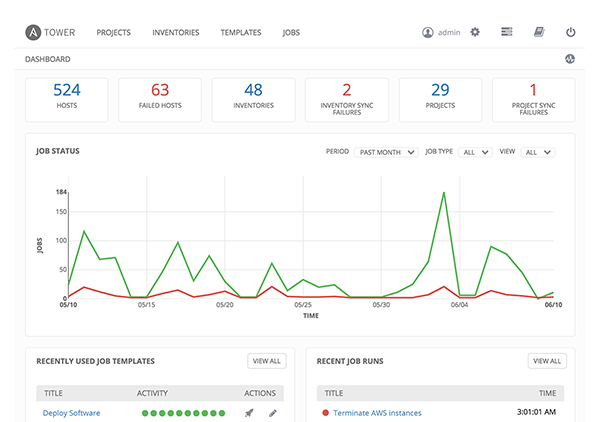With Ansible Automation, Red Hat Insights Can Resolve Critical Infrastructure Outages Security Risks
Red Hat Insights cloud-based service is integrating with Ansible ‘playbooks’ to deliver abilities to automatically remediate outages or other issues that can impact infrastructure security, performance, and stability.

As existing workloads evolve and deployments grow in size and complexity, risk management is a key challenge for enterprise IT.
So, Red Hat Insights cloud-based service is adding capabilities designed to automatically remediate outages or other issues that can impact infrastructure security, performance, and stability The Red Hat Insights SaaS (software-as-a-Service) provides continuous, in-depth analysis of an organization’s Red Hat-based infrastructure – across physical, virtual, off-prem cloud and even container deployments.
In specific, Red Hat Insights can now be integrated with Ansible ‘playbooks’ to bring faster problem-solving to Red Hat infrastructure. Ansible, a popular open source automation technology for managing IT environments at scale, was acquired by Red Hat in 2015.
The marriage of Red Hat Insights with Red hat Ansible offers strong benefits to both IT and business users, according to Joe Fitzgerald, vice president of Red Hat’s management solutions.
“Modern enterprise IT environments employ a complex and highly dynamic mix of services and technologies, making continuous identification and remediation of security and stability issues key for mission-critical operations,” he said in a statement.
With this feature update, Red Hat is bringing together automation, scale and predictive analytics to identifying and resolving issues that can impact apps performance, data access, ability to scale to a huge user base and many more baseline requirements of a digital business, he added.
“Manual identification and resolution of these issues can be expensive, time-consuming and more error prone,” Fitzgerald noted, “which is why we have added the automation capabilities of Ansible Playbooks to the latest version of Red Hat Insights.”
In a recent blog post, Ansible by Red Hat’s general manager Todd Barr explained why bringing Ansible automation to Red Hat Insights helps business – not simply IT stakeholders:
Automation transformed factories. It gave manufacturing the ability to perform work faster, more efficiently, at higher quality. Processes became predictable. Productivity thrived. Factories that failed to automate fell behind. Automation became a business imperative.
IT departments are the modern factories powering today’s digital businesses. And just as today’s factories can’t compete without automation, automation will soon become imperative for IT organizations.
“With Ansible, automation frees admins up to focus on efforts that help deliver more value to the business by speeding time to application delivery,” Barr said. To encourage adoption, Ansible uses a simple automation language that can describe any IT application infrastructure, he added.
Red Hat Insights Adds Power of Ansible Automation To Predictive Analytics
“Red Hat Insights is powered by predictive analytics,” Fitzgerald added. “It learns and gets smarter with every additional piece of intelligence and data. It can automatically discover relevant insights, proactively recommend tailored next actions and even automate tasks.” Red Hat Insights customers benefit from the experience and technical knowledge of Red Hat Certified Engineers, making it easier to identify, prioritize and resolve issues before business operations are affected.
Red Hat Insights gives businesses the ability to predict and prevent problems before they occur by providing:
Predictive analytics: Red Hat Insights provides comprehensive analytics across physical, virtual, container, private, and public cloud environments. This helps businesses save time and money addressing problems after the fact.
Less human error, rapid time to value: with Red Hat Insights, organizations can deploy and scale quickly with no additional infrastructure requirements. Teams can immediately initiate tailored remediation steps, allowing them to decrease security threats and avoid downtime.
Automated expert assessment: Red Hat Insights provides real-time visibility of hybrid environments and enables ops teams to identify pending outages and fix things faster, see potential problems and issues in real-time, without the need to wait for reactive error reports and logs, then fix with ease.
Avoid downtime: With proactive detection and automated remediation, enterprises can better manage security and stability threats to their Red Hat infrastructure, helping to avoid downtime and giving IT teams back time to focus on tasks that align with business goals.
The latest edition of the cloud-based Red Hat Insights service includes:
- Automated remediation reduces the mean time to resolution for critical security risks. Featuring Ansible Playbook creation, the Red Hat Insights console now can translate predictive intelligence into actions, enabling users to automatically remediate Insights findings - helping to more quickly and cost-effectively close infrastructure risks.
- Integration of Ansible Tower by Red Hat enables dynamically-generated Ansible Playbooks to be more rapidly deployed in a highly-scalable, more secure manner. This helps provide faster remediation and allows for the extension of Insights into automation and self-service use cases.
- Ansible-based configuration playbook is designed to streamline large and small deployments of the Red Hat Insights client to reduce installation time and effort and helps to provide Insights scalability as infrastructure needs grow.
- Expanded reporting displays historical trends in addition to a snapshot of the current infrastructure health so enterprises can more easily see their current risk assessment and what trends will most likely impact their IT estate.
Red Hat Insights is available to Red Hat customers to purchase via the Red Hat Customer Portal, Red Hat Satellite, Red Hat CloudForms, or Ansible Tower. It is also available via a public Red Hat Insights API.






